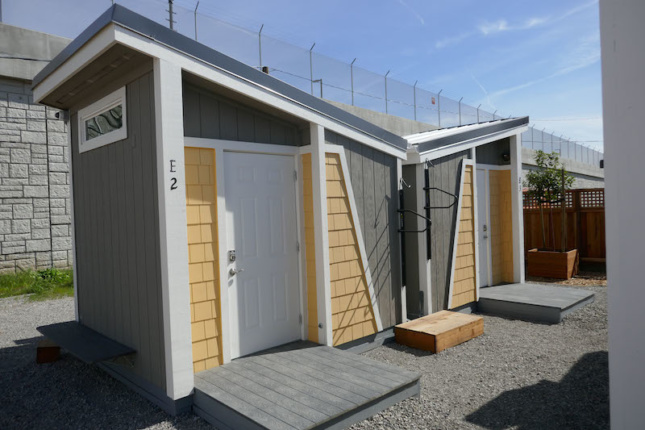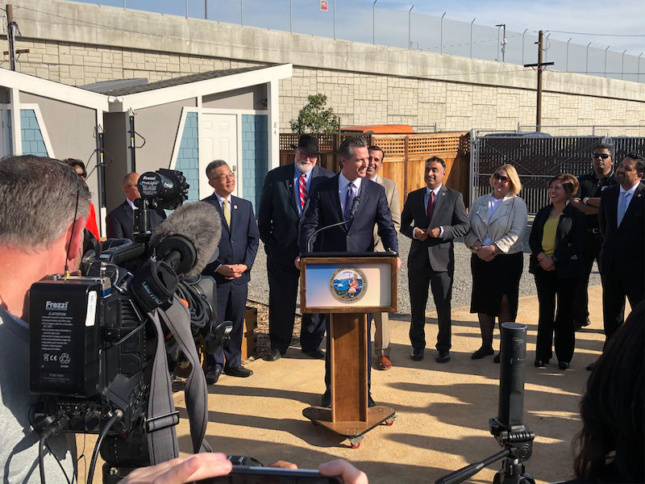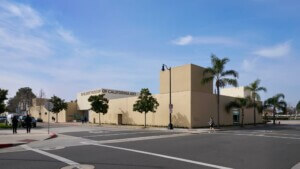Over three years in the making, a San Jose, California, pilot community composed of 40 ultra-tiny houses that will provide temporary shelter to Californians transitioning out of homelessness.
Dubbed the Mabury Bridge Housing Project, the village is located on a vacant parcel of land owned by the Valley Transit Authority and is one of two tiny house clusters planned for California’s third most populous city. The second community, located on Caltrans-owned land, is slated to open to residents later this year.
Like the rest of California, San Jose, the county seat of wildly affluent Santa Clara County and the de facto capital of Silicon Valley, is in the midst of a homelessness epidemic. As of January 2019, the number of people sleeping in their cars, on the streets, and in shelters within San Jose city limits had increased by 42 percent to 6,172 when compared to 2017 when the last Department of Housing and Urban Development-mandated homelessness census was taken. The current number is likely higher.

Built by a small army of Habitat for Humanity volunteers at a cost of $6,500 each, the micro-homes—or “emergency sleeping cabins,” as San Jose officials have dubbed them—measure a mere 80-square-feet, and two are slightly larger to accommodate residents with disabilities. Each single-occupancy living space is equipped with air conditioning/heating units, a twin bed, desk, and shelving. Laundry, shower, and storage facilities are located on-site along with a shared kitchen and ample communal space for socializing and stretching out. A community garden and resource center equipped with computers and job boards are also available to residents. The compound, which includes on-site parking, staff offices, and around-the-clock security, is fenced-in to “control foot traffic in and out of the site,” according to the pilot website.
HomeFirst, a San Jose-based nonprofit dedicated to lifting people out of homelessness, is the community’s operator and provides residents with resources beyond temporary housing including healthcare assistance and career training.
Residents at Mabury Bridge Housing Project are limited to 60-day stays as they continue down the path to self-sufficiency with the ultimate goal of securing permanent housing. As the Mercury News explained, the “unconventional” community located off of Mabury Road in the shadow of the Bayshore Freeway and opposite the yet-to-open Berryessa BART station to the northeast of downtown San Jose, “offers a mix of stability and compassion for those trying to stay afloat in spite of the region’s chronic shortage of affordable housing.”

The Mercury News explained that officials aim to house roughly 120 permanent housing-seeking residents each year, rotating 40 people out—and into permanent housing—every four months. San Jose Inside also noted that two residents have already moved on to permanent housing since the community first opened.
Yet at the grand opening ceremony in late February, an event attended by California Governor Gavin Newsom and San Jose Mayor Sam Liccardo, only eight of the community’s 40 cabins were occupied due to restrictions, including background checks, placed on eligible residents, who must be part of Santa Clara County’s rapid rehousing voucher program and actively be seeking permanent housing. Although the community has only been open for a little over a month, there’s been an early struggle in finding qualified people in need to populate the community.
“People get lost in the system,” Jacky Morales-Ferrand, housing director for the City of San Jose, told the Mercury News. “And, that’s actually one of the benefits of creating these interim sites, because as we create housing opportunities for people to move in, we know that we can connect them very quickly.”

In total, the pilot program on Mabury Road cost roughly $2 million, a sum that includes the 40 volunteer-built cabins, site development, and building out the community’s various support structures.
“It’s a question of scale. It’s a question of capacity. It’s a question of resolve, and so I just want you to know that we are resolved to scale programs like this,” said Newsom at the grand opening of the community. “The state vision to solve this crisis will be realized at the local level, project by project.”











